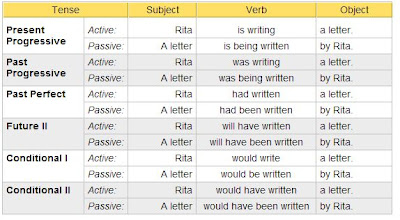Passive Voice
Use of Passive
Passive voice is used when the focus is on the action. It is not important or not known, however, who or what is performing the action.
Example: My bike was stolen.
In the example above, the focus is on the fact that my bike was stolen. I do not know, however, who did it.
Sometimes a statement in passive is more polite than active voice, as the following example shows:
Example: A mistake was made.
In this case, I focus on the fact that a mistake was made, but I do not blame anyone (e.g. You have made a mistake.).
Form of Passive
Subject + finite form of to be + Past Participle (3rd column of irregular verbs)
Example: A letter was written.
When rewriting active sentences in passive voice, note the following:
- the object of the active sentence becomes the subject of the passive sentence
- the finite form of the verb is changed (to be + past participle)
- the subject of the active sentence becomes the object of the passive sentence (or is dropped)
Examples of Passive
More Examples of Passive
Passive Sentences with Two Objects
Rewriting an active sentence with two objects in passive voice means that one of the two objects becomes the subject, the other one remains an object. Which object to transform into a subject depends on what you want to put the focus on.
Phrasal Verbs(some examples)
Phrasal verbs are usually two-word phrases consisting of verb + adverb or verb + preposition. Think of them as you would any other English vocabulary. Study them as you come across them, rather than trying to memorize many at once. Use the list below as a reference guide when you find an expression that you don't recognize. The examples will help you understand the meanings. If you think of each phrasal verb as a separate verb with a specific meaning, you will be able to remember it more easily. Like many other verbs, phrasal verbs often have more than one meaning.












0 comentários:
Enviar um comentário